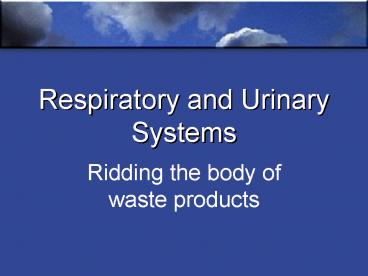Respiratory and Urinary Systems - PowerPoint PPT Presentation
Title:
Respiratory and Urinary Systems
Description:
Title: Blue Sky Border Author: user Last modified by: tal Created Date: 12/6/2006 4:10:11 PM Document presentation format: On-screen Show Company: Oregon School District – PowerPoint PPT presentation
Number of Views:41
Avg rating:3.0/5.0
Title: Respiratory and Urinary Systems
1
Respiratory and Urinary Systems
- Ridding the body of waste products
2
Assignment
- Rd 403 410
- Pg 428 S/A 2, 3, 8
- Clinic 5
- Rd 479 491
- Pg 501 S/A 1, 11, 15
- Clinic 1, 3
3
Respiratory System--video
4
Respiratory SystemFunction
- To supply oxygen to the blood while removing
carbon dioxide from the blood - Filter, warm, and humidify air
- Some organs influence speech and smell
5
Physiology of Respiration
- Respiration is made up of 4 distinct events
- Pulmonary ventilationbreathing air into/out of
lungs - Inspiration diaphragm and intercostal muscles
contract which opens the thoracic cavity. This
causes a vacuum and air rushes into lungs - Expiration normally a passive process. As the
muscles relax, the thoracic cavity becomes
smaller so that air is forced out of lungs
6
Physiology cont
- External respirationgas exchange between blood
and the alveoli via the capillaries surrounding
the alveoli (takes place in the lungs)
7
Physiology cont
- Respiratory gas exchange (Circulatory system
function)O2/CO2 must be transported to/from the
lungs and cells of body - Internal respiration (Circulatory system
function)gas exchange made at the capillaries
8
Urinary System
9
Kidneyfunction
- Form urinewaste products are filtered from blood
and enter nephron. Additional wastes may be
secreted into urine as well. - Helps to regulate many substances in the blood
10
Formation of Urine
- Combination of three processes
- Filtering
- Reabsorption
- Secretion
11
Formation of Urine
- Filtrationcontinuous process in each glomerulus
- 125ml/min 180 L fluid filtered by kidneys each
dayno one voids that much! - Most of the filtered substances are reabsorbed
into the body.
12
Formation of Urine
- Reabsorption
- 178 L/day of liquid is reabsorbed into body
- Glucose (usually) , amino acids, etcanything the
body needs will usually be reabsorbed. - Sodium reabsorption rates varydepending on
amount in body
13
Reabsorption cont
- Nitrogenous wastes are not reabsorbed
- Ureaformed by liver as end product of protein
breakdown when amino acids are used as energy - Uric acidwhen nucleic acids are broken down
- Creatinegenerally associated with physiology of
muscles
14
Formation of Urine
- Secretion
- H, K, and drugs are deposited into urine
- Video of the process
15
Pathologies
16
Disorders
- SIDSSudden Infant Death Syndrome
- Infants in seemingly good health die in their
sleep. Some cases are attributed to breathing
mechanisms not functioning correctly, others of
heart abnormalities. Most cases of unexplained
infant death get listed as SIDS
17
Disorders
- Cystic Fibrosis
- Most common lethal genetic disease
- Oversecretion of mucus that clogs the respiratory
passages putting person (usually a child) at risk
for fatal infections
- Affects other systems as welldigestive system
(clogs ducts that deliver pancreatic enzymes and
bile to SI)
18
Disorders
- Emphysemacondition where the alveoli enlarge
this chronic inflammation leads to fibrosis of
the lungs.
- Fibrosis makes the lungs less elastic so people
have to force air in AND OUT of the lungsleaving
them exhausted. - Usually caused by smoking
19
Disorders
- Pneumonialung infection that can be caused by
bacteria, viruses, fungi or parasites. - Most commonly caused by viruses.
- Bronchitismucosa of the lower respiratory
passages are severely inflamed and producing
excessive amounts of mucus. This excess mucus
impairs ventilation and gas exchange.
20
Disorders
- Sinusitisinfection of the sinuses
- Sinus headachepassages from the sinuses to nose
are blocked causing a partial vacuum and a
localized headache in the sinuses occurs.
21
Disorders
- Asthmacaused by chronically inflamed,
hypersensitive bronchial passages that respond to
many irritants with coughing, wheezing, and
impaired respiration. - Pleurisyinflammation of the pleura
22
Urinary Disorders
- Ptosisamount of fatty tissue surrounding kidneys
declines to such an extent that the kidneys
dropcan cause ureters to kink - Oliguriaabnormally low urine output (100
400ml/day). Usually indicates a problem with the
kidneys ability to filter wastes - Anurialess than 100ml of urine produced per day
23
Urinary Disorders
- Polyuriaan excess of 2.5L of urine produced a
day. - Incontinencevoiding involuntarily
- UTIUrinary Tract Infection
- Any infection of any portion of the kidneys,
ureters, bladder or urethra.
24
Urinary Disorders
- Renal calculikidney stones
- Concentrated urine solutes in the kidneys form
crystalline stones that they have to pass
through the ureters and out the urethra. The
ureters are much narrower than the urethra, so
the passage from kidney to bladder is the most
agonizing - Renal colicpain caused by passing kidney stone
25
Urinary Disorders
26
Urinary System Videos
- Used on a day when I had students taking their
own notes in the lab - http//www.youtube.com/watch?vzEpUQkQ-uKM
- http//www.youtube.com/watch?vYlQfBvKodQclistPL
E51F5D5980FDDBF7 - http//www.youtube.com/watch?vJBsUUYZKAlUlistPL
E51F5D5980FDDBF7































